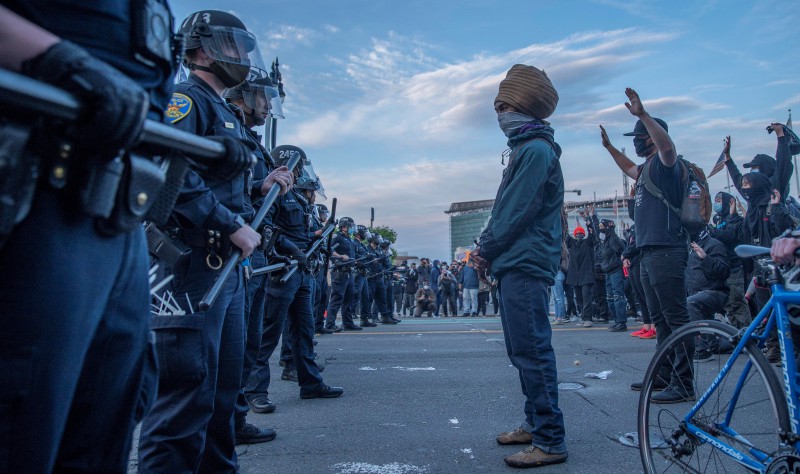
Scholars argue that reform is needed to address the unjust practices of law enforcement officers.
The killings of Duante Wright, George Floyd, Breonna Taylor, and a number of other Black victims have reignited global attention to the unconscionable deaths that occur at the hands of police officers. Because of the institutional disparities that lead to disproportionate numbers of racially charged deaths by police, many policymakers and activists are looking to regulatory and policy reforms to address these deeply rooted systemic issues.
In a recent article, Brandon L. Garrett of Duke University School of Law and Christopher Slobogin of Vanderbilt Law School argue that police officers need greater regulatory oversight to protect poor and minority citizens from unnecessary violence. Through examples from other countries, Garrett and Slobogin show how current law in the United States is complicit in furthering these disparities.
Garrett and Slobogin argue that current U.S. law provides police officers with wide discretion when using deadly force. This discretion ignores or even facilitates unnecessarily aggressive police action, especially against Black individuals. Instead of federal reforms that may be more challenging to implement, Garrett and Slobogin call for regulatory efforts that will empower local entities to change the landscape of police brutality.
Police use of force is one of the leading causes of death for Black men in the United States. According to Garrett and Slobogin, these disparities arise from a variety of causes, including institutionalized racism, residential segregation, poor officer training, and inadequate screening of police recruits.
But Garrett and Slobogin also claim that excessive use of police force is a product of a lack of centralized regulation. Unlike in countries such as Germany, the United States has failed to adopt a comprehensive set of statutes that regulate police conduct and provide uniformity and structure.
The lack of uniformity in policing in the United States has deep, historic roots. The nation has over 18,000 police departments, and Garrett and Slobogin contend that U.S. Congress has never properly regulated these local departments—even though it has the authority to do so under the Fourteenth Amendment. Because of the federal government’s decision not to intervene with the authority of local police entities, a large portion of the nationally applicable rules for the police have been handled by the courts.
Garrett and Slobogin claim that regulating the police with constitutional rules handed down from the courts has several limitations. Because judicial rules tend to be broad, fact-specific, and rigid, courts cannot make determinations quickly.
In addition, Garrett and Slobogin reveal that U.S. Supreme Court decisions related to deadly force do not provide guidance for how to judge whether any specific police action was “reasonable.” These Supreme Court decisions also do not reference acceptable or required training or tactics, nor do they hold police officers accountable for going with their gut instead of following training and policy.
Even in situations where officers shoot individuals in the back as they attempt to drive away, or where officers shoot persons they knew were mentally ill, the Court holds that these officers acted “reasonably” within the standards of established law and are therefore protected. The reliance on constitutional law allows judges to deem police use of deadly force justifiable, even in circumstances where officers may be, by moral standards, abusing their law enforcement authority.
Garrett and Slobogin contrast policing in the United States with that in Europe, where police do not physically detain as many arrestees or confront as many citizens. As the number of police arrests and stops drop, so too does the potential for arbitrary police stops and arrests that increase tensions with poor communities of color. Garrett and Slobogin argue that these tensions damage police-citizen relations in U.S. neighborhoods and lead to resistant actions, such as Black Lives Matter protests, Defund the Police initiatives, and other reform efforts.
Garrett and Slobogin claim that regulatory reform must be multifaceted with a specific focus on local efforts. Although federal regulations aspire to standardize regulatory efforts, localized reforms aim to address militarized tactical teams, the use of invasive surveillance technologies, and stop, search, and arrest practices. In addition, local reforms would change how police departments establish mechanisms for independent review of “critical incidents,” remove certain custodial penalties, and reduce excessive use of the criminal law to authorize stops and arrests.
Because of its “racially disparate impact,” U.S. policing is in urgent need of change, Garrett and Slobogin conclude. They hope that, by shifting away from federal reforms and moving efforts toward local entities, the U.S. criminal enforcement system can better address racial discrimination, systemic disparities, and policing abuse.
Garrett and Slobogin look optimistically to a time when, with the help of activists, lawmakers, and the courts, trailblazing reform to policing can be on its way.



